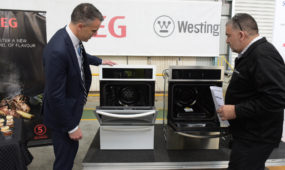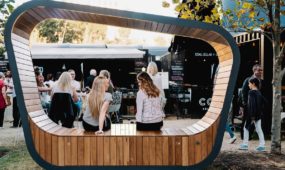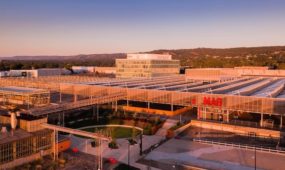Finding new footholds in dwindling golf manufacturing industry
Manufacturing
DIVERSIFYING its offering, low debt and recruiting new brands is proving to be crucial to the survival of one of Australia’s last golf club manufacturers.

Sign up to receive notifications about new stories in this category.
Thank you for subscribing to story notifications.
Dynacast Golf has been assembling golf clubs south of Adelaide since the 1980s but has had to reinvent itself in recent years as the sun sets on the sport’s boom times.
One of Australia’s biggest entry-level golf club brands in the 1980s and ’90s, Dynacast produced about 250,000 clubs a year and employed 15 full-time manufacturing staff to assemble them under the guidance of Managing Director Eric Rowe.
While Eric is still heavily involved with the business, his son Daniel now plays a big role in the day-to-day running of the Dynacast Group as its General Manager.
Daniel said the introduction of home brands at major chain stores such as Drummond Golf and House of Golf, coupled with the increased availability of cheap imports and a decline in the growth of golf in Australia had forced Dynacast to gradually shift its focus.
“That cheap entry level set side of the market that used to boom has dried right up, so diversification’s had to come along,” Daniel said.
Dynacast began to diversify in when it became the Australian wholesaler and distributor for Garmin Golf GPS devices in 2011. It became a distributor for KBS golf shafts in 2012 and an assembly centre and distributor for Bridgestone Golf in 2014. It is the only place in the world outside of Japan and the United States attested to assemble Bridgestone clubs, which it makes for the Australian and New Zealand markets.
While Bridgestone is still a relatively small player in the golf club market in Australia, its golf balls, which are also distributed by Dynacast, are among the biggest sellers worldwide.
“We’ve picked up more brands now so that gives us more scope. People like dealing with less suppliers so if you are more of a one-stop-shop it gives them less reason to shop at other places,” Daniel said.
“We were fortunate enough and the business was set up well enough that we’ve been able to shoulder a lot of blows, deal with the industry changes and be in a strong enough financial position to weather these storms.
“There are definitely positives. We’re in an industry where two or three years ago myself and dad were looking at it and it was a bit disheartening where the whole game was going.
“This year we’re seeing very good growth over last year in an industry that’s generally not seeing growth so we’re quite optimistic looking forward – there’s definitely going to be road blocks there but I think there’s also good opportunities and we’re going into it with enthusiasm.”
Dynacast, a small golf shop called Yankalilla Golf Factory when Eric took over in 1983, still produces its own brands from imported components but its manufacturing has reduced to about 50,000 clubs a year and includes junior clubs and mini-golf supplies.
Now there is just one assembler and one staff member assigned to cleaning and dispatch at its Lonsdale plant, where it has been located since 2006.
Daniel said the strengths of assembling in Australia were maintaining the ability to customise products more easily so they can cater to specific demands and reduced freight costs while the big downside was cost.
“You can get a club assembled in China for a dollar,” he said.
“The industry has changed a lot in the last decade or two it’s gone from absolute boom times to thinning right out,” Daniel said.
According to the 2015 National Golf Club Participation Report, golf membership in Australia peaked in 1998 at about 500,000 golfers. Since then it has steadily declined by 21 per cent to 397,063 in 2015. More than 50 per cent of golf club members are aged over 55. Just 19 per cent of club members are aged under 35.
The previous factory in McLaren Vale was set up with the majority of the space for assembly whereas the 1750sq m purpose-built Lonsdale facility is designed with a large warehousing space and relatively small assembly workshop.
“Before, the assembly was pretty steady but we didn’t have any storage when we made it. Now we’ve got massive storage so we can just keep production going all the time so it’s just a steady flow and when an order comes in we’ve already got it made up,” Daniel said.
“You’ve just got to find your foothold, you cut down your costs, you have less staff so at the end of the day you can turnover less. We’ve still got all the connections out there – 700-odd accounts that we’re dealing with – so we’re still viable. “
“The ability to carry bigger stock holdings has been big for us as well. Our biggest advantage is that we basically own everything we’ve got including our stock and premises.
“While we’ve had to diversify, the core of what we do has still stayed the same – we still service the golf industry and we still glue together golf clubs but there’s a bit more emphasis now on pick and pack. You just pick up a box of golf balls off the shelf and you dispatch – it’s a much simpler concept than manufacturing golf clubs.
“Over the years we might bring in a little more pre-assembled but it is a strength being able to assemble your own products as you need it. The customization side of the market there’s still definitely a call for that. We might whittle it down a little bit but I don’t ever think we’ll get to the point where we’re not manufacturing.”
Jump to next article



